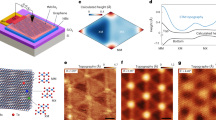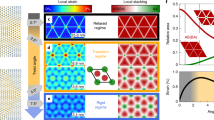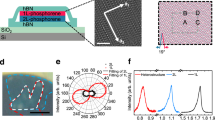Abstract
Moiré photonic structures permit the engineering of optical band structures and light–matter interactions, offering new opportunities in photonics and optoelectronics, paving the way for new nanophotonic applications such as ultra-low threshold lasing, and versatile nonlinear and quantum light sources; however, the lack of in situ tunability has limited the potential of these structures until now. For example, the lack of control of the twist angle is an obstacle to high-resolution material spectroscopy and the development of new applications that require moiré optical properties. Here we present a microelectromechanical system (MEMS)-integrated twisted moiré photonic crystal sensor with a tunable interlayer distance and twist angle. The MEMS actuators modulate the wavelength and polarization resonances of the photonic crystal sensor via a twist- and gap-tuned moiré scattering effect. Using a reconstruction algorithm, this chip-based sensor can be used to simultaneously resolve the spectrum and polarization state of a wide-band signal in the telecommunications range and the full Poincaré sphere. We also demonstrate hyperspectral and hyperpolarimetric imaging using this single sensor. Our research illustrates some of the remarkable applications of multidimensional control of degrees of freedom in twisted moiré photonic platforms and establishes a scalable pathway towards creating comprehensive flat-optics devices suitable for versatile light manipulation and information processing.
This is a preview of subscription content, access via your institution
Access options
Access Nature and 54 other Nature Portfolio journals
Get Nature+, our best-value online-access subscription
$32.99 / 30 days
cancel any time
Subscribe to this journal
Receive 12 print issues and online access
$259.00 per year
only $21.58 per issue
Buy this article
- Purchase on SpringerLink
- Instant access to full article PDF
Prices may be subject to local taxes which are calculated during checkout





Similar content being viewed by others
Data availability
The data that support the plots within this paper are available from the corresponding authors on reasonable request.
Code availability
The code used in this paper is available from the corresponding authors on reasonable request.
References
Yang, Z., Albrow-Owen, T., Cai, W. & Hasan, T. Miniaturization of optical spectrometers. Science 371, eabe0722 (2021).
Bao, J. & Bawendi, M. G. A colloidal quantum dot spectrometer. Nature 523, 67–70 (2015).
Yoon, H. H. et al. Miniaturized spectrometers with a tunable van der Waals junction. Science 378, 296–299 (2022).
Yuan, S. et al. Geometric deep optical sensing. Science 379, eade1220 (2023).
Wang, Z. et al. Single-shot on-chip spectral sensors based on photonic crystal slabs. Nat. Commun. 10, 1020 (2019).
Lee, S., Peng, R., Wu, C. & Li, M. Programmable black phosphorus image sensor for broadband optoelectronic edge computing. Nat. Commun. 13, 1485 (2022).
Meng, J., Cadusch, J. J. & Crozier, K. B. Detector-only spectrometer based on structurally colored silicon nanowires and a reconstruction algorithm. Nano Lett. 20, 320–328 (2020).
Yang, Z. et al. Single-nanowire spectrometers. Science 365, 1017–1020 (2019).
Yuan, S., Naveh, D., Watanabe, K., Taniguchi, T. & Xia, F. A wavelength-scale black phosphorus spectrometer. Nat. Photon. 15, 601–607 (2021).
Kong, L. et al. Single-detector spectrometer using a superconducting nanowire. Nano Lett. 21, 9625–9632 (2021).
Deng, W. et al. Electrically tunable two-dimensional heterojunctions for miniaturized near-infrared spectrometers. Nat. Commun. 13, 4627 (2022).
Ma, C. et al. Intelligent infrared sensing enabled by tunable moiré quantum geometry. Nature 604, 266–272 (2022).
Wang, J. et al. Continuous-spectrum-polarization recombinant optical encryption with a dielectric metasurface. Adv. Mater. 35, e2304161 (2023).
Xiong, J. et al. Dynamic brain spectrum acquired by a real-time ultraspectral imaging chip with reconfigurable metasurfaces. Optica 9, 461–468 (2022).
Gao, L., Qu, Y., Wang, L. & Yu, Z. Computational spectrometers enabled by nanophotonics and deep learning. Nanophotonics 11, 2507–2529 (2022).
Wang, C.-Y. et al. Gate-tunable van der Waals heterostructure for reconfigurable neural network vision sensor. Sci. Adv. 6, eaba6173 (2020).
Wang, Z. & Yu, Z. Spectral analysis based on compressive sensing in nanophotonic structures. Opt. Express 22, 25608–25614 (2014).
Ahmed, T. et al. Neuromorphic imaging: fully light‐controlled memory and neuromorphic computation in layered black phosphorus. Adv. Mater. 33, 2170074 (2021).
Jang, M. et al. Wavefront shaping with disorder-engineered metasurfaces. Nat. Photon. 12, 84–90 (2018).
Yu, S., Qiu, C.-W., Chong, Y., Torquato, S. & Park, N. Engineered disorder in photonics. Nat. Rev. Mater. 6, 226–243 (2020).
Gigan, S. Imaging and computing with disorder. Nat. Phys. 18, 980–985 (2022).
Tang, H. et al. Experimental probe of twist angle-dependent band structure of on-chip optical bilayer photonic crystal. Sci. Adv. 9, eadh8498 (2023).
Lou, B. et al. Theory for twisted bilayer photonic crystal slabs. Phys. Rev. Lett. 126, 136101 (2021).
Lou, B., Wang, B., Rodríguez, J. A., Cappelli, M. & Fan, S. Tunable guided resonance in twisted bilayer photonic crystal. Sci. Adv. 8, eadd4339 (2022).
Liu, S. et al. Moiré metasurfaces for dynamic beamforming. Sci. Adv. 8, eabo1511 (2022).
Tang, H. et al. Modeling the optical properties of twisted bilayer photonic crystals. Light Sci. Appl. 10, 157 (2021).
Tang, H., Ni, X., Du, F., Srikrishna, V. & Mazur, E. On-chip light trapping in bilayer moiré photonic crystal slabs. Appl. Phys. Lett. 121, 231702 (2022).
Wang, P. et al. Localization and delocalization of light in photonic moiré lattices. Nature 577, 42–46 (2020).
Huang, L., Zhang, W. & Zhang, X. Moiré quasibound states in the continuum. Phys. Rev. Lett. 128, 253901 (2022).
Nguyen, D. X. et al. Magic configurations in moiré superlattice of bilayer photonic crystals: almost-perfect flatbands and unconventional localization. Phys. Rev. Res. 4, L032031 (2022).
Yi, C.-H., Park, H. C. & Park, M. J. Strong interlayer coupling and stable topological flat bands in twisted bilayer photonic moir‚ superlattices. Light Sci. Appl. 11, 289 (2022).
Dong, K. et al. Flat bands in magic-angle bilayer photonic crystals at small twists. Phys. Rev. Lett. 126, 223601 (2021).
Chen, J. et al. A perspective of twisted photonic structures. Appl. Phys. Lett. 119, 240501 (2021).
Raun, A., Tang, H., Ni, X., Mazur, E. & Hu, E. L. GaN magic angle laser in a merged moiré photonic crystal. ACS Photon. 10, 3001–3007 (2023).
Mao, X.-R., Shao, Z.-K., Luan, H.-Y., Wang, S.-L. & Ma, R.-M. Magic-angle lasers in nanostructured moiré superlattice. Nat. Nanotechnol. 16, 1099–1105 (2021).
Oudich, M. et al. Photonic analog of bilayer graphene. Phys. Rev. B 103, 214311 (2021).
Zhang, T. et al. Twisted moiré photonic crystal enabled optical vortex generation through bound states in the continuum. Nat. Commun. 14, 6014 (2023).
Ni, X. et al. Three-dimensional reconfigurable optical singularities in bilayer photonic crystals. Phys. Rev. Lett. 132, 073804 (2024).
Du, L. et al. Moiré photonics and optoelectronics. Science 379, eadg0014 (2023).
Hu, G., Krasnok, A., Mazor, Y., Qiu, C.-W. & Alù, A. Moiré hyperbolic metasurfaces. Nano Lett. 20, 3217–3224 (2020).
Hu, G. et al. Topological polaritons and photonic magic angles in twisted α-MoO3 bilayers. Nature 582, 209–213 (2020).
Hu, G., Zheng, C., Ni, J., Qiu, C.-W. & Alù, A. Enhanced light–matter interactions at photonic magic-angle topological transitions. Appl. Phys. Lett. 118, 211101 (2021).
Sunku, S. S. et al. Photonic crystals for nano-light in moiré graphene superlattices. Science 362, 1153–1156 (2018).
Chen, M. et al. Configurable phonon polaritons in twisted α-MoO3. Nat. Mater. 19, 1307–1311 (2020).
Zhang, Q. et al. Interface nano-optics with van der Waals polaritons. Nature 597, 187–195 (2021).
Krasnok, A., Tymchenko, M. & Alù, A. Nonlinear metasurfaces: a paradigm shift in nonlinear optics. Mater. Today 21, 8–21 (2018).
Fu, Q. et al. Optical soliton formation controlled by angle twisting in photonic moiré lattices. Nat. Photon. 14, 663–668 (2020).
Arkhipova, A. A. et al. Observation of linear and nonlinear light localization at the edges of moiré arrays. Phys. Rev. Lett. 130, 083801 (2023).
Yao, K. et al. Enhanced tunable second harmonic generation from twistable interfaces and vertical superlattices in boron nitride homostructures. Sci. Adv. 7, eabe8691 (2021).
Ha, S. et al. Enhanced third-harmonic generation by manipulating the twist angle of bilayer graphene. Light Sci. Appl. 10, 19 (2021).
Du, L., Dai, Y. & Sun, Z. Twisting for tunable nonlinear optics. Matter 3, 987–988 (2020).
Tang, H. et al. On-chip multi-degree-of-freedom control of two-dimensional materials. Nature 632, 1038–1044 (2024).
Zhou, H. et al. Control of chirality and directionality of nonlinear metasurface light source via moiré engineering. Phys. Rev. Lett. 134, 043801 (2024).
Förtsch, M. et al. A versatile source of single photons for quantum information processing. Nat. Commun. 4, 1818 (2013).
Park, J. et al. All-solid-state spatial light modulator with independent phase and amplitude control for three-dimensional LiDAR applications. Nat. Nanotechnol. 16, 69–76 (2021).
Salary, M. M. & Mosallaei, H. Time-modulated conducting oxide metasurfaces for adaptive multiple access optical communication. IEEE Trans. Antennas Propag. 68, 1628–1642 (2020).
Kapfer, M. et al. Programming twist angle and strain profiles in 2D materials. Science 381, 677–681 (2023).
Wang, D. et al. Thermally induced graphene rotation on hexagonal boron nitride. Phys. Rev. Lett. 116, 126101 (2016).
Liao, M. et al. UItra-low friction and edge-pinning effect in large-lattice-mismatch van der Waals heterostructures. Nat. Mater. 21, 47–53 (2022).
Ribeiro-Palau, R. et al. Twistable electronics with dynamically rotatable heterostructures. Science 361, 690–693 (2018).
Qin, H. et al. Arbitrarily polarized bound states in the continuum with twisted photonic crystal slabs. Light Sci. Appl. 12, 66 (2023).
Overvig, A., Yu, N. & Alù, A. Chiral quasi-bound states in the continuum. Phys. Rev. Lett. 126, 073001 (2021).
Compressed Sensing (Cambridge Univ. Press, 2012).
Kilic, V., Tran, T. D. & Foster, M. A. Compressed sensing in photonics: tutorial. J. Opt. Soc. Am. B 40, 28–52 (2023).
Yesilkoy, F. et al. Ultrasensitive hyperspectral imaging and biodetection enabled by dielectric metasurfaces. Nat. Photon. 13, 390–396 (2019).
Faraji-Dana, M. et al. Hyperspectral imager with folded metasurface optics. ACS Photon. 6, 2161–2167 (2019).
Zuo, J. et al. Chip-integrated metasurface full-Stokes polarimetric imaging sensor. Light Sci. Appl. 12, 218 (2023).
Rubin, N. A. et al. Matrix Fourier optics enables a compact full-Stokes polarization camera. Science 365, eaax1839 (2019).
Guyon, O. Extreme adaptive optics. Annu. Rev. Astron. Astrophys. 56, 315–355 (2018).
Rigaut, F. & Neichel, B. Multiconjugate adaptive optics for astronomy. Annu. Rev. Astron. Astrophys. 56, 277–314 (2018).
She, A., Zhang, S., Shian, S., Clarke, D. R. & Capasso, F. Adaptive metalenses with simultaneous electrical control of focal length, astigmatism, and shift. Sci. Adv. 4, eaap9957 (2018).
Acknowledgements
We thank D. Güney, S. Kocaman, G. Zhong and Y. Liu for discussions. We thank F. Capasso and M. Loncar for the access to the optical instruments, electrical instruments and other facilities. E.M., H.T. and F.D. acknowledge support from NSF (ECCS-2234513) and DARPA (URFAO: GR510802). S.F. and L.B. acknowledge the support from the US Air Force Office of Scientific Research (grant no. FA9550-21-1-0244), and from the US Office of Naval Research (grant no. N00014-20-1-2450). A.Y. acknowledges support from the Army Research Office under grant no. W911NF-21-2-0147 and the Gordon and Betty Moore Foundation through grant GBMF 9468. E.H. acknowledges support from NSF (ECCS-2234513). The sample fabrication was performed at Harvard University Center for Nanoscale Systems, which is a member of the National Nanotechnology Coordinated Infrastructure Network and is supported by the National Science Foundation under NSF award 1541959.
Author information
Authors and Affiliations
Contributions
Several people contributed to the work described in this paper. H.T. and B.L. conceived the basic idea for this work. H.T and B.L. prepared the paper and Supplementary Information. H.T. and Y.C. designed the MEMS and optics device, performed the nanofabrication, designed the electrical measurement set-up and performed the experiments. G.G, F.D. and H.T. performed optical measurements. B.L. and G.G. designed the reconstruction algorithm and performed measurement data analysis for sensing and imaging. M.Z., X.N., H.T. and B.L. performed numerical simulations and analytical calculations. E.M., S.F., Y.C. and H.T. supervised the research and development of the paper. All authors subsequently took part in the revision process, approved the final copy and provided feedback on the paper throughout its development.
Corresponding authors
Ethics declarations
Competing interests
The authors declare no other competing interests.
Peer review
Peer review information
Nature Photonics thanks the anonymous reviewers for their contribution to the peer review of this work.
Additional information
Publisher’s note Springer Nature remains neutral with regard to jurisdictional claims in published maps and institutional affiliations.
Extended data
Extended Data Fig. 1 Illustration fabrication process.
(a) Vias drilling and coating. (b) Photonic crystal (PhC) fabrication. (c) MEMS process. (d) Vapour releasing. (e) Top layer fabrication and bonding. Blue: Silicon. Grey: Silicon oxide. Purple: Silicon Nitride. Orange: Conductive layer. Yellow: SU-8.
Extended Data Fig. 2
The sideview of the packaged MEMS-TMPhC device wire bonded to printed circuit board.
Extended Data Fig. 3 Illustration of vertical actuator driving principle.
The vertical actuator consists of a parallel capacitor that provides a driving force downwards, and a lever that magnifies the vertical translation 4 times in the reversed direction.
Extended Data Fig. 4 Illustration of rotary three-phase stepper driving principle.
(a) Illustration of the rotary actuator with three-phase electrode. (b) Driving microstepping voltage waveform for driving the rotary actuator.
Extended Data Fig. 5 Band structure measurement of moiré PhC.
(a) Schematic of the measurement set-up. The red line represents the incident light, its direct transmission, and radiation-induced scattering from the bilayer lattice. POL - Polarizer; QWP - Quarter-Wave Plate; L - Lens; OBJ - Objective Lens. (b) Band structure measured by stacking iso-frequency contours for each wavelength. The dashed line area on the top surface shows the iso-frequency contour, and the cross-section reveals the band structure. (c) Band structure measured by SuperK laser.
Extended Data Fig. 6 Simulated far-field polarization distribution in the momentum space for different moiré photonic crystal configurations.
Far-field polarization distribution in the momentum space when \(\theta =\) 12° and \(h=400\) nm (top row), \(\theta =\) 12° and \(h=500\) nm (middle row), and \(\theta =\) 10° and \(h=500\) nm (bottom row). The polarization fields of emitting upward and downward are different. The blue ellipse represents left-hand polarization (LCP) states, and the orange ellipse represents right-hand polarization (RCP) states. The winding centres of the LCP and RCP are the polarization singularity C-point. The rotational center of the two PhC slabs are perfectly aligned.
Supplementary information
Supplementary Information
Supplementary Figs. 1–7 and Tables 1 and 2 for illustration purposes.
Supplementary Video 1
Real-time measurement for the dynamic tuning of the moiré pattern.
Supplementary Video 2
Band structures for different Vz (interlayer gaps).
Supplementary Video 3
Iso-frequency contour for different Vz (interlayer gaps).
Supplementary Video 4
Band structures for different twist angle.
Supplementary Video 5
Iso-frequency contour for different twist angles.
Supplementary Video 6
Iso-frequency contour when rotating quater-wave plate.
Supplementary Video 7
Iso-frequency contour when rotating polarizer.
Rights and permissions
Springer Nature or its licensor (e.g. a society or other partner) holds exclusive rights to this article under a publishing agreement with the author(s) or other rightsholder(s); author self-archiving of the accepted manuscript version of this article is solely governed by the terms of such publishing agreement and applicable law.
About this article
Cite this article
Tang, H., Lou, B., Du, F. et al. An adaptive moiré sensor for spectro-polarimetric hyperimaging. Nat. Photon. 19, 463–470 (2025). https://doi.org/10.1038/s41566-025-01650-z
Received:
Accepted:
Published:
Issue date:
DOI: https://doi.org/10.1038/s41566-025-01650-z



